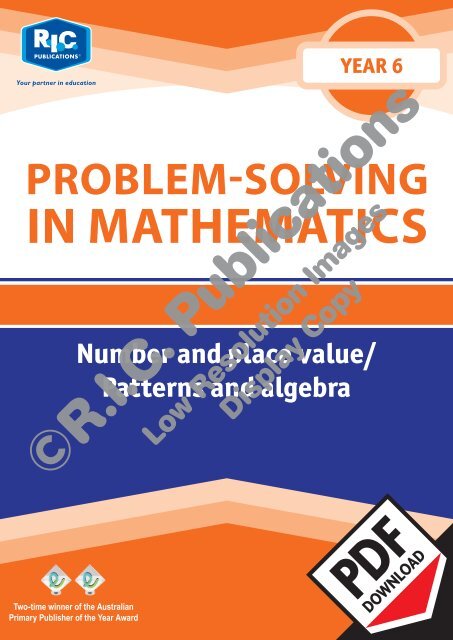20774_Problem_solving_Year_6_Number_and_place_value_Patterns_and_algebra_1
You also want an ePaper? Increase the reach of your titles
YUMPU automatically turns print PDFs into web optimized ePapers that Google loves.
Your partner in education<br />
YEAR 6<br />
PROBLEM-SOLVING<br />
IN MATHEMATICS<br />
<strong>Number</strong> <strong>and</strong> <strong>place</strong> <strong>value</strong>/<br />
<strong>Patterns</strong> <strong>and</strong> <strong>algebra</strong><br />
Two-time winner of the Australian<br />
Primary Publisher of the <strong>Year</strong> Award
<strong>Problem</strong>-<strong>solving</strong> in mathematics<br />
(Book G)<br />
Published by R.I.C. Publications ® 2008<br />
Copyright © George Booker <strong>and</strong><br />
Denise Bond 2007<br />
RIC–<strong>20774</strong><br />
This master may only be reproduced by the<br />
original purchaser for use with their class(es). The<br />
publisher prohibits the loaning or onselling of this<br />
master for the purposes of reproduction.<br />
Copyright Notice<br />
Blackline masters or copy masters are published <strong>and</strong><br />
sold with a limited copyright. This copyright allows<br />
publishers to provide teachers <strong>and</strong> schools with a<br />
wide range of learning activities without copyright<br />
being breached. This limited copyright allows the<br />
purchaser to make sufficient copies for use within<br />
their own education institution. The copyright is not<br />
transferable, nor can it be onsold. Following these<br />
instructions is not essential but will ensure that you,<br />
as the purchaser, have evidence of legal ownership<br />
to the copyright if inspection occurs.<br />
For your added protection in the case of copyright<br />
inspection, please complete the form below. Retain<br />
this form, the complete original document <strong>and</strong> the<br />
invoice or receipt as proof of purchase.<br />
Name of Purchaser:<br />
Date of Purchase:<br />
Supplier:<br />
School Order# (if applicable):<br />
Signature of Purchaser:<br />
Internet websites<br />
In some cases, websites or specific URLs may be recommended. While these are checked <strong>and</strong> rechecked at the time of publication,<br />
the publisher has no control over any subsequent changes which may be made to webpages. It is strongly recommended that the class<br />
teacher checks all URLs before allowing students to access them.<br />
View all pages online<br />
PO Box 332 Greenwood Western Australia 6924<br />
Website: www.ricpublications.com.au<br />
Email: mail@ricgroup.com.au
FOREWORD<br />
Books A–G of <strong>Problem</strong>-<strong>solving</strong> in mathematics have been developed to provide a rich resource for teachers<br />
of students from the early years to the end of middle school <strong>and</strong> into secondary school. The series of problems,<br />
discussions of ways to underst<strong>and</strong> what is being asked <strong>and</strong> means of obtaining solutions have been built up to<br />
improve the problem-<strong>solving</strong> performance <strong>and</strong> persistence of all students. It is a fundamental belief of the authors<br />
that it is critical that students <strong>and</strong> teachers engage with a few complex problems over an extended period rather than<br />
spend a short time on many straightforward ‘problems’ or exercises. In particular, it is essential to allow students<br />
time to review <strong>and</strong> discuss what is required in the problem-<strong>solving</strong> process before moving to another <strong>and</strong> different<br />
problem. This book includes extensive ideas for extending problems <strong>and</strong> solution strategies to assist teachers in<br />
implementing this vital aspect of mathematics in their classrooms. Also, the problems have been constructed <strong>and</strong><br />
selected over many years’ experience with students at all levels of mathematical talent <strong>and</strong> persistence, as well as<br />
in discussions with teachers in classrooms, professional learning <strong>and</strong> university settings.<br />
<strong>Problem</strong>-<strong>solving</strong> does not come easily to most people,<br />
so learners need many experiences engaging with<br />
problems if they are to develop this crucial ability. As<br />
they grapple with problem, meaning <strong>and</strong> find solutions,<br />
students will learn a great deal about mathematics<br />
<strong>and</strong> mathematical reasoning; for instance, how to<br />
organise information to uncover meanings <strong>and</strong> allow<br />
connections among the various facets of a problem<br />
to become more apparent, leading to a focus on<br />
organising what needs to be done rather than simply<br />
looking to apply one or more strategies. In turn, this<br />
extended thinking will help students make informed<br />
choices about events that impact on their lives <strong>and</strong> to<br />
interpret <strong>and</strong> respond to the decisions made by others<br />
at school, in everyday life <strong>and</strong> in further study.<br />
Student <strong>and</strong> teacher pages<br />
The student pages present problems chosen with a<br />
particular problem-<strong>solving</strong> focus <strong>and</strong> draw on a range<br />
of mathematical underst<strong>and</strong>ings <strong>and</strong> processes.<br />
For each set of related problems, teacher notes <strong>and</strong><br />
discussion are provided, as well as indications of<br />
how particular problems can be examined <strong>and</strong> solved.<br />
Answers to the more straightforward problems <strong>and</strong><br />
detailed solutions to the more complex problems<br />
ensure appropriate explanations, the use of the<br />
pages, foster discussion among students <strong>and</strong> suggest<br />
ways in which problems can be extended. Related<br />
problems occur on one or more pages that extend the<br />
problem’s ideas, the solution processes <strong>and</strong> students’<br />
underst<strong>and</strong>ing of the range of ways to come to terms<br />
with what problems are asking.<br />
At the top of each teacher page, there is a statement<br />
that highlights the particular thinking that the<br />
problems will dem<strong>and</strong>, together with an indication<br />
of the mathematics that might be needed <strong>and</strong> a list<br />
of materials that could be used in seeking a solution.<br />
A particular focus for the page or set of three pages<br />
of problems then exp<strong>and</strong>s on these aspects. Each<br />
book is organised so that when a problem requires<br />
complicated strategic thinking, two or three problems<br />
occur on one page (supported by a teacher page with<br />
detailed discussion) to encourage students to find<br />
a solution together with a range of means that can<br />
be followed. More often, problems are grouped as a<br />
series of three interrelated pages where the level of<br />
complexity gradually increases, while the associated<br />
teacher page examines one or two of the problems in<br />
depth <strong>and</strong> highlights how the other problems might be<br />
solved in a similar manner.<br />
R.I.C. Publications ® www.ricpublications.com.au <strong>Problem</strong>-<strong>solving</strong> in mathematics<br />
iii
FOREWORD<br />
Each teacher page concludes with two further aspects<br />
critical to successful teaching of problem-<strong>solving</strong>. A<br />
section on likely difficulties points to reasoning <strong>and</strong><br />
content inadequacies that experience has shown may<br />
well impede students’ success. In this way, teachers<br />
can be on the look out for difficulties <strong>and</strong> be prepared<br />
to guide students past these potential pitfalls. The<br />
final section suggests extensions to the problems to<br />
enable teachers to provide several related experiences<br />
with problems of these kinds in order to build a rich<br />
array of experiences with particular solution methods;<br />
for example, the numbers, shapes or measurements<br />
in the original problems might change but leave the<br />
means to a solution essentially the same, or the<br />
context may change while the numbers, shapes or<br />
measurements remain the same. Then numbers,<br />
shapes or measurements <strong>and</strong> the context could be<br />
changed to see how the students h<strong>and</strong>le situations<br />
that appear different but are essentially the same<br />
as those already met <strong>and</strong> solved. Other suggestions<br />
ask students to make <strong>and</strong> pose their own problems,<br />
investigate <strong>and</strong> present background to the problems<br />
or topics to the class, or consider solutions at a more<br />
general level (possibly involving verbal descriptions<br />
<strong>and</strong> eventually pictorial or symbolic arguments).<br />
In this way, not only are students’ ways of thinking<br />
extended but the problems written on one page are<br />
used to produce several more problems that utilise<br />
the same approach.<br />
Mathematics <strong>and</strong> language<br />
The difficulty of the mathematics gradually increases<br />
over the series, largely in line with what is taught<br />
at the various year levels, although problem-<strong>solving</strong><br />
both challenges at the point of the mathematics<br />
that is being learned as well as provides insights<br />
<strong>and</strong> motivation for what might be learned next. For<br />
example, the computation required gradually builds<br />
from additive thinking, using addition <strong>and</strong> subtraction<br />
separately <strong>and</strong> together, to multiplicative thinking,<br />
where multiplication <strong>and</strong> division are connected<br />
conceptions. More complex interactions of these<br />
operations build up over the series as the operations<br />
are used to both come to terms with problems’<br />
meanings <strong>and</strong> to achieve solutions. Similarly, twodimensional<br />
geometry is used at first but extended<br />
to more complex uses over the range of problems,<br />
then joined by interaction with three-dimensional<br />
ideas. Measurement, including chance <strong>and</strong> data, also<br />
extends over the series from length to perimeter, <strong>and</strong><br />
from area to surface area <strong>and</strong> volume, drawing on<br />
the relationships among these concepts to organise<br />
solutions as well as giving an underst<strong>and</strong>ing of the<br />
metric system. Time concepts range from interpreting<br />
timetables using 12-hour <strong>and</strong> 24-hour clocks while<br />
investigations related to mass rely on both the concept<br />
itself <strong>and</strong> practical measurements.<br />
The language in which the problems are expressed is<br />
relatively straightforward, although this too increases<br />
in complexity <strong>and</strong> length of expression across the books<br />
in terms of both the context in which the problems<br />
are set <strong>and</strong> the mathematical content that is required.<br />
It will always be a challenge for some students<br />
to ‘unpack’ the meaning from a worded problem,<br />
particularly as problems’ context, information <strong>and</strong><br />
meanings exp<strong>and</strong>. This ability is fundamental to the<br />
nature of mathematical problem-<strong>solving</strong> <strong>and</strong> needs to<br />
be built up with time <strong>and</strong> experiences rather than be<br />
iv<br />
<strong>Problem</strong>-<strong>solving</strong> in mathematics www.ricpublications.com.au R.I.C. Publications ®
FOREWORD<br />
diminished or left out of the problems’ situations. One<br />
reason for the suggestion that students work in groups<br />
is to allow them to share <strong>and</strong> assist each other with<br />
the tasks of discerning meanings <strong>and</strong> ways to tackle<br />
the ideas in complex problems through discussion,<br />
rather than simply leaping into the first ideas that<br />
come to mind (leaving the full extent of the problem<br />
unrealised).<br />
An approach to <strong>solving</strong> problems<br />
Try<br />
an approach<br />
Explore<br />
means to a solution<br />
Analyse<br />
the problem<br />
The careful, gradual development of an ability to<br />
analyse problems for meaning, organising information<br />
to make it meaningful <strong>and</strong> to make the connections<br />
among them more meaningful in order to suggest<br />
a way forward to a solution is fundamental to the<br />
approach taken with this series, from the first book<br />
to the last. At first, materials are used explicitly to<br />
aid these meanings <strong>and</strong> connections; however, in<br />
time they give way to diagrams, tables <strong>and</strong> symbols<br />
as underst<strong>and</strong>ing <strong>and</strong> experience of <strong>solving</strong> complex,<br />
engaging problems increases. As the problem forms<br />
exp<strong>and</strong>, the range of methods to solve problems<br />
is carefully extended, not only to allow students to<br />
successfully solve the many types of problems, but<br />
also to give them a repertoire of solution processes<br />
that they can consider <strong>and</strong> draw on when new<br />
situations are encountered. In turn, this allows them<br />
to explore one or other of these approaches to see<br />
whether each might furnish a likely result. In this way,<br />
when they try a particular method to solve a new<br />
problem, experience <strong>and</strong> analysis of the particular<br />
situation assists them to develop a full solution.<br />
Not only is this model for the problem-<strong>solving</strong> process<br />
helpful in <strong>solving</strong> problems, it also provides a basis for<br />
students to discuss their progress <strong>and</strong> solutions <strong>and</strong><br />
determine whether or not they have fully answered<br />
a question. At the same time, it guides teacher<br />
questions of students <strong>and</strong> provides a means of seeing<br />
underlying mathematical difficulties <strong>and</strong> ways in<br />
which problems can be adapted to suit particular<br />
needs <strong>and</strong> extensions. Above all, it provides a common<br />
framework for discussions between a teacher <strong>and</strong><br />
group or whole class to focus on the problem-<strong>solving</strong><br />
process rather than simply on the solution of particular<br />
problems. Indeed, as Alan Schoenfeld, in Steen L (Ed)<br />
Mathematics <strong>and</strong> democracy (2001), states so well, in<br />
problem-<strong>solving</strong>:<br />
getting the answer is only the beginning rather than<br />
the end … an ability to communicate thinking is<br />
equally important.<br />
We wish all teachers <strong>and</strong> students who use these<br />
books success in fostering engagement with problem<strong>solving</strong><br />
<strong>and</strong> building a greater capacity to come to<br />
terms with <strong>and</strong> solve mathematical problems at all<br />
levels.<br />
George Booker <strong>and</strong> Denise Bond<br />
R.I.C. Publications ® www.ricpublications.com.au <strong>Problem</strong>-<strong>solving</strong> in mathematics<br />
v
CONTENTS<br />
Foreword .................................................................. iii – v<br />
Contents .......................................................................... vi<br />
Introduction ........................................................... vii – xix<br />
A note on calculator use ................................................ xx<br />
Teacher notes................................................................... 2<br />
Surface area...................................................................... 3<br />
Volume <strong>and</strong> surface area................................................. 4<br />
Surface area <strong>and</strong> volume................................................. 5<br />
Teacher notes................................................................... 6<br />
The farmers market.......................................................... 7<br />
Teacher notes................................................................... 8<br />
Profit <strong>and</strong> loss.................................................................. 9<br />
Calculator patterns........................................................ 10<br />
Puzzle scrolls.................................................................. 11<br />
Teacher notes................................................................. 12<br />
Weather or not............................................................... 13<br />
Showtime....................................................................... 14<br />
Probably true.................................................................. 15<br />
Teacher notes................................................................. 16<br />
Wilderness explorer....................................................... 17<br />
Teacher notes................................................................. 18<br />
Changing lockers............................................................ 19<br />
Cycle days...................................................................... 20<br />
Puzzle scrolls.................................................................. 21<br />
Teacher notes................................................................. 22<br />
Office hours.................................................................... 23<br />
At the office................................................................... 24<br />
Out of office................................................................... 25<br />
Teacher notes................................................................. 26<br />
<strong>Number</strong> patterns............................................................ 27<br />
Teacher notes................................................................. 28<br />
Magic squares............................................................... 29<br />
Sudoku........................................................................... 30<br />
Alphametic puzzles........................................................ 31<br />
Teacher notes................................................................. 32<br />
At the shops................................................................... 33<br />
The plant nursery........................................................... 34<br />
On the farm.................................................................... 35<br />
Teacher notes................................................................. 36<br />
Fisherman’s wharf.......................................................... 37<br />
Teacher notes................................................................. 38<br />
Making designs.............................................................. 39<br />
Squares <strong>and</strong> rectangles................................................. 40<br />
Designer squares........................................................... 41<br />
Teacher notes................................................................. 42<br />
How many?..................................................................... 43<br />
How far?......................................................................... 44<br />
How much?..................................................................... 45<br />
Teacher notes................................................................. 46<br />
Prospect Plains............................................................... 47<br />
Teacher notes................................................................. 48<br />
Money matters............................................................... 49<br />
Scoring points................................................................ 50<br />
Puzzle scrolls.................................................................. 51<br />
Teacher notes.................................................................. 52<br />
Riding to work................................................................. 53<br />
Bike tracks....................................................................... 54<br />
Puzzle scrolls................................................................... 55<br />
Teacher notes.................................................................. 56<br />
Farm work....................................................................... 57<br />
Farm produce.................................................................. 58<br />
Selling fish...................................................................... 59<br />
Teacher notes.................................................................. 60<br />
Rolling along................................................................... 61<br />
Solutions .................................................................62–71<br />
Isometric resource page .............................................. 72<br />
0–99 board resource page ........................................... 73<br />
4-digit number exp<strong>and</strong>er resource page (x 3) .............. 74<br />
10 mm x 10 mm grid resource page ........................... 75<br />
15 mm x 15 mm grid resource page ............................ 76<br />
Triangular grid resource page ...................................... 77<br />
vi<br />
<strong>Problem</strong>-<strong>solving</strong> in mathematics www.ricpublications.com.au R.I.C. Publications ®
TEACHER NOTES<br />
<strong>Problem</strong>-<strong>solving</strong><br />
To read, interpret <strong>and</strong> analyse information<br />
Materials<br />
calculator<br />
Focus<br />
These pages explore concepts of <strong>place</strong> <strong>value</strong>, number<br />
sense <strong>and</strong> using data. The relationships among numbers<br />
<strong>and</strong> <strong>place</strong> <strong>value</strong> is analysed <strong>and</strong> students are encouraged<br />
to not only find possibilities but to also disregard numbers<br />
<strong>and</strong> combinations that are not possible. Data needs to be<br />
interpreted <strong>and</strong> analysed to find solutions. See the note on<br />
using a calculator (page xx) for ways to use the different<br />
functions.<br />
Discussion<br />
Page 9<br />
This investigation requires students to read <strong>and</strong> interpret<br />
information <strong>and</strong> use this information to find a solution.<br />
Students need to think in terms of fixed costs occurring<br />
regardless of income <strong>and</strong> variable costs occurring<br />
according to production. The variable cost per item is<br />
not given as such <strong>and</strong> students need to use information<br />
regarding 500 items which have a variable cost of $7500<br />
to identity that the variable cost per item is $15.<br />
Once the table is complete the data can then be used to<br />
work out at which point the factory moves from making a<br />
loss to making a profit. The point at which this occurs is<br />
not shown in the table <strong>and</strong> students need to take what<br />
they know—that she is making a loss at 100 items but<br />
making a profit at 250 <strong>and</strong> somewhere in between is<br />
where the break-even point will occur.<br />
Page 10<br />
These problems are easy to state <strong>and</strong> investigate using<br />
a calculator’s memory function to simplify the steps <strong>and</strong><br />
assist in developing <strong>algebra</strong>ic thinking as the patterns<br />
described in words for the examples used are translated<br />
into early proofs in general. The first problem investigates<br />
a pattern based on the difference of two squares that<br />
was first used in Book E, but now the focus is on why<br />
the result would be true in general. The second problem<br />
is an investigation based on the difference of two cubes.<br />
The pattern can be discerned as the examples are worked<br />
through using the calculator, but showing why this is<br />
true in general requires quite sophisticated <strong>algebra</strong>ic<br />
reasoning which should be underst<strong>and</strong>able by the children<br />
but not necessarily a form of thinking they would come to<br />
by themselves.<br />
Page 11<br />
The puzzle scrolls contain a number of different problems,<br />
all involving strategic thinking to find possible solutions. In<br />
most cases students will find tables, lists <strong>and</strong> diagrams are<br />
needed to manage the data while exploring the different<br />
possibilities. In some cases the information needs to<br />
be analysed to find a pattern to find out solutions. For<br />
example, in the investigation involving ‘3 digit numbers<br />
adding to 6’ the possible solutions from numbers in the one<br />
hundreds can then be used to determine other numbers in<br />
the 2 hundreds <strong>and</strong> so on.<br />
The scroll exploring 3-digit numbers when dividing by 5<br />
<strong>and</strong> 7 would mean that each number had to end in a 3 or<br />
an 8. The first 3-digit number divisible by 7 is 105. If we<br />
add 2 to this number we get 107 which can be our starting<br />
number for looking for other numbers. If we key 107 into<br />
a calculator, add 7 <strong>and</strong> press equal it will keep adding 7<br />
each time. If we then record any numbers which end in a<br />
3 or an 8 <strong>and</strong> we have the numbers which will result in a<br />
remainder of 3 when dividing by 5 <strong>and</strong> a remainder of 2<br />
when dividing by 7.<br />
For the scroll exploring the number of beads students can<br />
again think in terms of multiples. If they find 13 by 8 (the<br />
first 3-digit multiple of 8) which is 104, add one to this<br />
number to give the starting number. Again a calculator can<br />
be used (add 8, press the equal key <strong>and</strong> it will add 8 each<br />
time). These numbers can be recorded <strong>and</strong> students can<br />
then look at multiples of 7 (with 1 added) <strong>and</strong> highlight<br />
any numbers that are the same <strong>and</strong> then, from these<br />
possibilities, check to see if it is also true for 6.<br />
Possible difficulties<br />
• Difficulty with the concepts of fixed cost <strong>and</strong> variable<br />
costs<br />
• Difficulty with the concept of profit <strong>and</strong> loss<br />
• Poor underst<strong>and</strong>ing of <strong>place</strong> <strong>value</strong><br />
• Wanting to add, subtract or multiply rather than using<br />
<strong>place</strong> <strong>value</strong> or number sense<br />
• Not using all the criteria<br />
Extension<br />
• Students could think up their own profit <strong>and</strong> loss<br />
problems using different criteria.<br />
• Students could make puzzle scroll cards where they<br />
take the existing card <strong>and</strong> change the numbers or<br />
context to make a new problem.<br />
8<br />
<strong>Problem</strong>-<strong>solving</strong> in mathematics www.ricpublications.com.au R.I.C. Publications ®
PROFIT AND LOSS<br />
A factory owner knows that some of her expenses are going to occur regardless of<br />
how many items she makes <strong>and</strong> sells. These are fixed costs <strong>and</strong> include things such as<br />
rent, insurance, phone <strong>and</strong> Internet. Her fixed costs total $4000 per week.<br />
Her other expenses are variable costs which change each week depending on the<br />
number of items she makes. Variable costs include things such as materials, labour<br />
<strong>and</strong> electricity.<br />
All factory items are made to order, so all items produced are sold. In one week she<br />
sold 500 items <strong>and</strong> her variable costs were $7500. All items sell at $50 each.<br />
1. Complete the table below to show the income for the shop based on the number of<br />
items sold as well as the total costs for each week.<br />
Items sold<br />
per week<br />
Income<br />
Total costs<br />
50 75 100 250 500 1000 1500 3000<br />
The difference between total costs <strong>and</strong> income is the factory owner’s profit. If she<br />
made no sales she would still have to pay the fixed costs <strong>and</strong> would have a loss for<br />
that week.<br />
2. Did she make a profit or a loss when she sold 100 items?<br />
3. Did she make a profit or a loss when she sold 1000 items?<br />
4. Using the information in the table, estimate the number of items she needs to sell<br />
each week to break even. Calculate the expenses <strong>and</strong> income for that number of items<br />
to check your estimate.<br />
R.I.C. Publications ® www.ricpublications.com.au <strong>Problem</strong>-<strong>solving</strong> in mathematics<br />
9
CALCULATOR PATTERNS<br />
Use your calculator to help think about what is happening.<br />
Squaring <strong>and</strong> multiplying<br />
1. Choose 3 consecutive 2-digit numbers; e.g. 69, 70, 71.<br />
(a) Multiply the first <strong>and</strong> third numbers.<br />
(b) Square the middle number.<br />
(c) What do you notice?<br />
(d) Try some other 2-digit numbers.<br />
(e) Try some 3-digit numbers <strong>and</strong> 4-digit numbers<br />
(f) Describe the pattern. Why does this happen?<br />
Cubing, squaring <strong>and</strong> multiplying<br />
2. Choose a 2-digit numbers; e.g. 47.<br />
(a) Make a new number by finding the difference between the cube of the tens digit<br />
<strong>and</strong> the cube of the ones digit.<br />
(b) Make another new number by adding the square of the tens digit, the square of<br />
the ones digit <strong>and</strong> the product of the tens <strong>and</strong> ones digits.<br />
(c) Divide the first new number by the second new number.<br />
(d) Try some other 2-digit numbers.<br />
(e) What do you notice?<br />
(f) Investigate what happens if you split a 3-digit number into 2 parts (there will be<br />
two different ways).<br />
(g) Describe the pattern. Can you explain why this happens?<br />
10<br />
<strong>Problem</strong>-<strong>solving</strong> in mathematics www.ricpublications.com.au R.I.C. Publications ®
PUZZLE SCROLLS<br />
1. Five paintbrushes <strong>and</strong> 2 sets<br />
of paints cost $19.25 while 3<br />
brushes <strong>and</strong> 4 sets of paints cost<br />
$29.75. How much does 1 set of<br />
paints cost?<br />
2. A box with over 100 beads can<br />
be shared among 6, 7 or 8 bags<br />
with 1 bead left over each time.<br />
What is the smallest number of<br />
beads that the box could have?<br />
3. The number 105 has a digit sum<br />
of 6 (1 + 0 + 5). How many other<br />
3-digit numbers have a digit sum<br />
of 6?<br />
4. When 54 is added to a number<br />
the result is the same as when<br />
the number is multiplied by 4.<br />
What is the number?<br />
5. What 3-digit numbers have a<br />
remainder of 3 when divided by<br />
5 <strong>and</strong> a remainder of 2 when<br />
divided by 7? How many did<br />
you find?<br />
6. Two cash registers had a<br />
combined total of $500. When<br />
$18 was taken from one register<br />
to the other, they each had the<br />
same amount. How much did<br />
they have before the transfer?<br />
R.I.C. Publications ® www.ricpublications.com.au <strong>Problem</strong>-<strong>solving</strong> in mathematics<br />
11
SOLUTIONS<br />
Note: Many solutions are written statements rather than just numbers. This is to encourage teachers <strong>and</strong> students to solve<br />
problems in this way.<br />
PROFIT AND LOSS ...................................................... page 9<br />
1.<br />
Items<br />
sold per<br />
week<br />
50 75 100 250 500 1000 1500 3000<br />
Income 2500 3750 5000 12 500 25 000 50 000 75 000 150 000<br />
Total<br />
costs<br />
4000 +<br />
750<br />
4000 +<br />
1125<br />
2. Loss<br />
3. Profit<br />
4. Between 100 <strong>and</strong> 250<br />
4000 +<br />
1500<br />
4000 +<br />
3750<br />
4000 +<br />
7500<br />
110 113 114 115<br />
Income 5500 5650 5700 5750<br />
Costs 4000 4000 4000 4000<br />
115 items<br />
1650 1645 1710 1725<br />
5560 5695 5710 5725<br />
4000 +<br />
15 000<br />
4 000 +<br />
22 500<br />
4000 +<br />
45 000<br />
CALCULATOR PATTERNS ........................................ page 10<br />
1. (a) 4899<br />
(b) 4900<br />
(c) difference of 1<br />
(d) <strong>Number</strong>s will vary but difference will always be 1<br />
(e) <strong>Number</strong>s will vary but difference will always be 1<br />
(f) For consecutive numbers, the product of the<br />
number before <strong>and</strong> the number after is 1 less than<br />
the number squared, number 2 .<br />
The number before is (number – 1),<br />
the number after is (number + 1)<br />
(number – 1) x (number +1)<br />
= number x number + number x 1<br />
– 1 x number – 1 x 1<br />
= number 2 + number – number – 1<br />
= number 2 – 1<br />
No matter what number is chosen, there will<br />
always be a difference of 1<br />
2. (a) 279<br />
(b) 93<br />
(c) 3<br />
(d) e.g. 47<br />
difference between 4 3 <strong>and</strong> 7 3 is 279<br />
4 2 + (4 x 7) + 7 2 = 93<br />
279 ÷ 93 = 3<br />
Try 83<br />
difference between 8 3 <strong>and</strong> 3 3 is 485<br />
8 2 + (8 x 3) + 3 2 = 97<br />
485 ÷ 97 = 5<br />
(e) answer is always the difference between the tens<br />
<strong>and</strong> ones digits<br />
(f) e.g. 346 is 34 <strong>and</strong> 6 or 3 <strong>and</strong> 46<br />
Difference is 28 or 43<br />
(g) Pattern<br />
when a 3 digit is split into two parts, the difference<br />
of the cubes of the parts divided by the sum of the<br />
squares <strong>and</strong> the product of the two parts is the<br />
same as the difference between the two parts.<br />
This result is a consequence of the <strong>algebra</strong>ic<br />
relationship<br />
a 3 – b 3 = (a – b) x (a 2 + ab + b 2 ). Showing students<br />
<strong>and</strong> asking them to substitute numbers for a <strong>and</strong><br />
b will show students it always works – this is<br />
the what the questions have asked them to do in<br />
words.<br />
Some students may be able to multiply out the<br />
brackets part by part in a similar way to the<br />
example above:<br />
(a – b) x (a 2 + ab + b 2 )<br />
= (a x a 2 ) + (a x ab) + (a x b 2 ) – (b x a 2 )<br />
– (b x ab) – (b x b 2 )<br />
= a3 + a 2 b + ab 2 – a 2 b –ab 2 – b 3<br />
= a 3 – b 3<br />
PUZZLE SCROLLS ...................................................... page 11<br />
1. $6.50<br />
2. 169<br />
3. 20<br />
4. 18<br />
5. 25<br />
6. $268 <strong>and</strong> $232<br />
R.I.C. Publications ® www.ricpublications.com.au <strong>Problem</strong>-<strong>solving</strong> in mathematics<br />
63


















